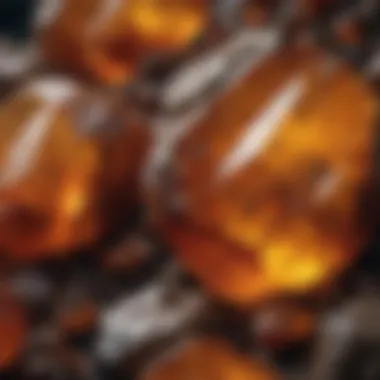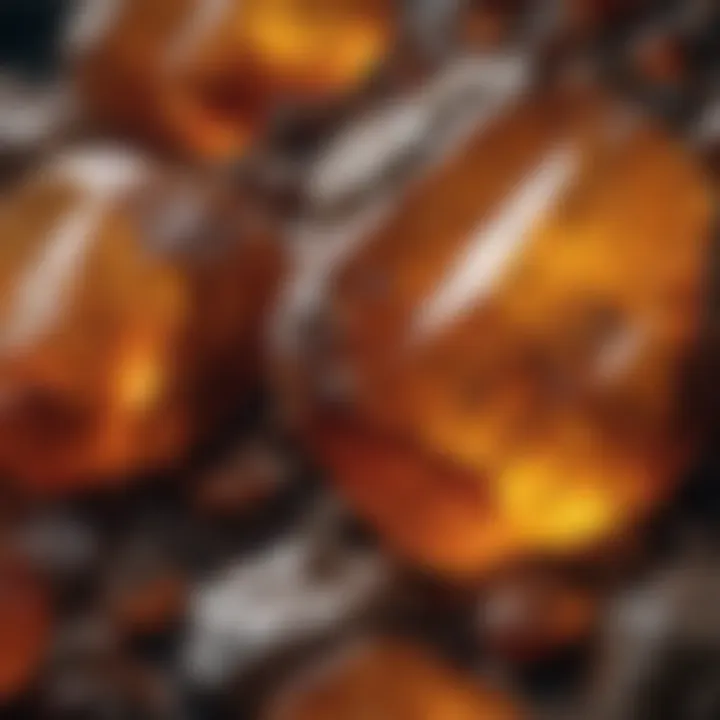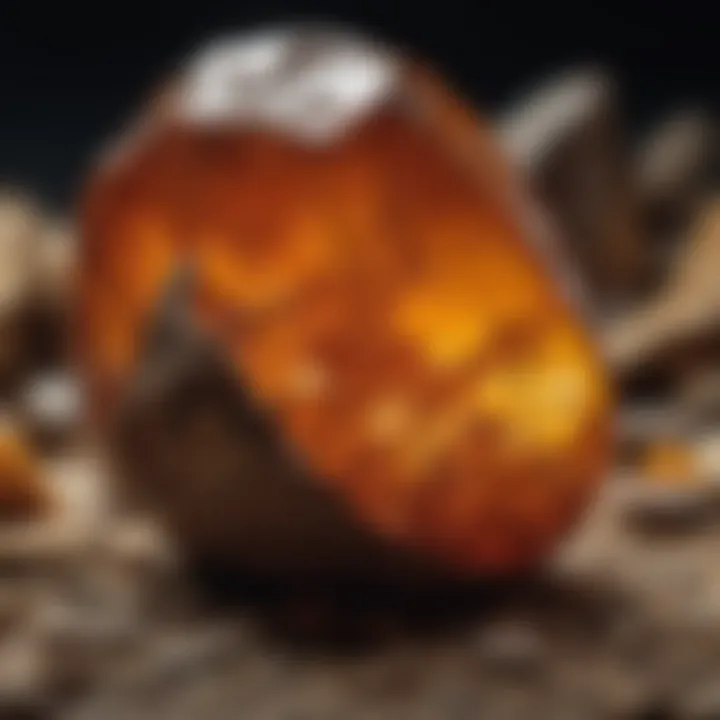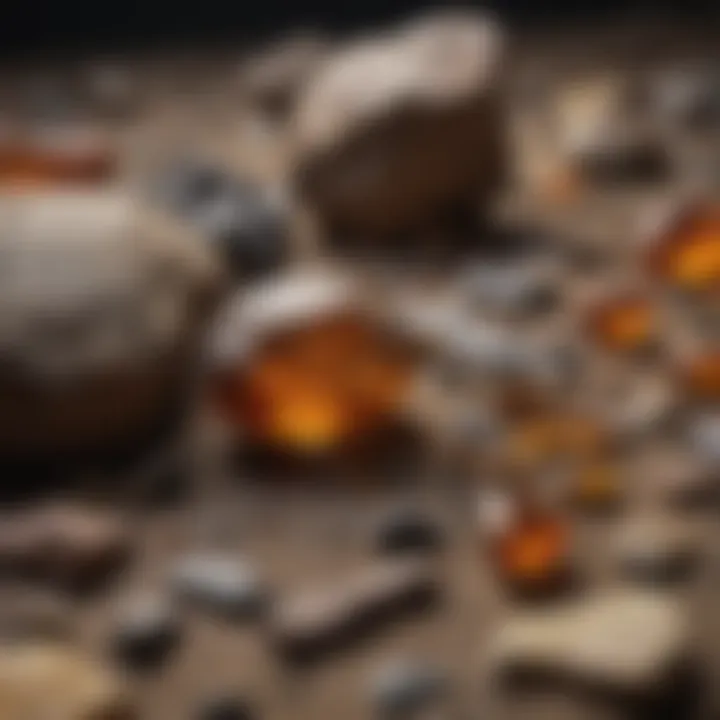In-Depth Analysis of Amber Rock and Its Significance


Intro
Amber rock, often mistaken for mere stones, harbors layers of history and science within its glossy surfaces. Formed through the ancient process of tree resin fossilization, it embodies a rich narrative that intertwines geology, history, and culture. This article aims to peel back the layers of amber rock, revealing its significance not only as a collectible but also as a testament to our planet's evolutionary journey. By examining the aesthetic allure of amber alongside practical collection and preservation tips, we invite enthusiasts and scholars alike to delve into its depths.
Featured Collectible of the Month
Overview
So what makes amber rock tick as a collectible? For one, its warm colors can mesmerize collectors. From glittering yellows to deep browns and greens, each piece tells its own story. Often, these fossils come encased with trapped insects or plant material, offering a glimpse into ecosystems past. This natural time capsule draws in both amateur collectors and seasoned geologists, who appreciate the intricate harmony of art and science that amber encapsulates.
Historical Significance
Historically, amber has been treasured across cultures, holding positions of power and value. In the ancient world, Greeks referred to it as "electron," believing that it possessed properties to attract other materials when rubbed. Fast forward through time, it became a coveted substance for amulets in ancient Egypt, aligning with beliefs of protection and healing.
Another notable point is amber's role in trade. Baltic amber, originating from the vast forests of Northern Europe, was once the backbone of an extensive trade network, known as the Amber Road. Merchants transported it right across Europe, leading to its integration in jewelry and royal artifacts alike, as featured in the art of many periods.
"Amber is like the gold of the north, a treasure of the earth that holds the memories of nature and time.”
Identification Techniques
To appreciate amber fully, one must master the art of identification.
Visual Characteristics
When evaluating a piece of amber, there are certain traits to look for:
- Color: Look for vibrant yellows, honey-like shades, or deep reds. Clear, bubble-free amber is considered more valuable.
- Inclusions: Real treasures are those that encapsulate life—tiny insects, leaves, or even air bubbles. These inclusions add both value and story.
- Transparency: True amber can range from translucent to opaque. The clarity gives hints about its age and authenticity.
Resources for Identification
To further refine your identification skills, consider these resources:
- Wikipedia's comprehensive outline on Amber offers a solid introduction to its properties and classifications.
- Britannica also includes historical and cultural perspectives, enriching your understanding.
- Online forums like Reddit host communities dedicated to amber collecting, where enthusiasts share insights and identification tips.
By employing these techniques and leveraging available resources, both new and seasoned collectors can deepen their appreciation for the storied life of amber rock. Meaningful collection and preservation practices further add to this journey, ensuring these precious stones remain a beacon of our planet’s bygone eras.
Prologue to Amber Rock
Amber rock, a captivating subject of study, holds great importance in both geological and cultural contexts. This article serves as a comprehensive guide, delving into the many facets of amber, aiming to enlighten both collectors and those with a scientific curiosity. Understanding amber is not just about appreciating its beauty; it involves comprehending its historical significance and the processes that form this unique substance.
Definition and Characteristics
Amber, often mistaken for a gemstone, is actually fossilized tree resin. Its warm, golden hues and intriguing inclusions make it a prized possession among collectors. One of the key characteristics of amber is its transparency, which ranges from clear to opaque, often showcasing beautiful, swirling patterns. These variations are caused by the conditions under which the resin was formed and its age.
In terms of physical properties, amber is relatively lightweight; a chunk can sometimes float in saltwater due to its low density. This distinctive quality, combined with its ability to preserve ancient organic matter, enhances its allure. It can contain various inclusions like insects, plant material, and even air bubbles from millions of years ago, making every piece a little window into the past.
The Formation Process of Amber
The journey of amber begins in ancient forests. When trees exude resin to heal wounds, this sap can either solidify on the bark or drip down and accumulate on the forest floor. Over millennia, this organic material undergoes a transformation. The process of polymerization gradually hardens the resin, eventually leading to the formation of amber.
Environmental conditions significantly influence this process. Ideal factors include warm temperatures and minimal exposure to oxygen, which allows the resin to undergo anaerobic decay. Geological activities can also play a role by burying the resin deep enough for heat and pressure to contribute to its fossilization.
As the resin petrifies, it can entrap various life forms, preserving them as inclusions. This encapsulation not only enhances its aesthetic appeal but also provides valuable data for scientists studying ancient climates and ecosystems.
"Amber is not merely a beautiful object; it is a preserved record of our planet's history."
Understanding amber's formation is crucial for collectors, as it sheds light on potential sources and avenues for acquiring diverse specimens. Knowing that the origins of amber date back tens of millions of years imbues it with a sense of timelessness that resonates deeply with enthusiasts.
Geological Significance of Amber
Amber isn't just a pretty trinket; it serves a far greater purpose in geological terms. This unique fossilized resin offers a window into our planet's distant past, presenting invaluable insights into ancient ecosystems and the creatures that inhabited them. Understanding the geological significance of amber impacts various fields, particularly paleontology and archaeology, making it a cornerstone for both scientific and cultural exploration.


Amber as a Fossilized Resin
Amber is the result of ancient tree resins that have undergone a remarkable transformation over millions of years. When these resins ooze from trees, they can trap and preserve specimens—think insects, pollen, and even small vertebrates. These inclusions not only tell us about the flora and fauna of the time but also provide snapshots of ecological interactions.
In scientific circles, the term 'fossilized resin' doesn’t just describe what amber is; it encapsulates a multitude of stories waiting to be uncovered. For instance, researchers have found that some inclusions in amber hold genetic material, offering a rare glimpse into the DNA of ancient species. This ability to encapsulate life in its entirety showcases amber’s potential to unlock secrets about biodiversity and evolution.
Role in Understanding Past Ecosystems
What makes amber particularly special is its role as a time capsule. The bits of life within amber can be used to reconstruct past ecosystems, allowing scientists to see how climate changes have influenced biodiversity. This understanding comes with an implication that stretches into current biodiversity and conservation studies. As climate change poses a serious threat to many species today, learning from the past through amber can help forecast potential futures of our ecosystems.
Moreover, the types of organisms found in amber can shed light on ancient environments. For example, discovering a tropical insect trapped in amber implies that those trees once thrived in warmer climates, helping reconstruct the paleoenvironment. This information is invaluable for predicting how current ecosystems might react to ongoing environmental changes, making amber a vital tool for scientists.
Geological Locations of Amber Deposits
When discussing amber, it’s essential to highlight its origins. Major deposits of amber can be found in regions like the Baltic Sea, the Dominican Republic, and Myanmar, each offering unique characteristics and historical contexts. The Baltic amber, often yellow or honey-colored, is famous in the jewelry world, but its geological significance extends far beyond aesthetics.
In the Dominican Republic, the amber is often noted for its inclusions of diverse species, some of which are not found in other regions. The amber from Myanmar, on the other hand, dates back to the Cretaceous period and provides incredibly rare specimens that aid in understanding the age of dinosaurs.
The geographical diversity of amber not only enhances its allure for collectors but also provides a rich tapestry of geological data. Each deposit tells its own tale, a patchwork of conditions that led to the formation of amber, giving it a significance that transcends mere beauty.
*"Amber does not simply remain stagnant; it evolves within the layers of history, each deposit a marker of time's passage and a legacy of life.
Historical Context and Uses of Amber
Amber has been treasured throughout history, holding a significance that stretches across cultures and epochs. It is not merely a stone; it is a witness to humanity's evolution, wrapped in the stories of civilizations that utilize it for varied purposes. Understanding the historical context of amber provides a lens through which we can appreciate its multifaceted roles — from ornamental use to metaphysical beliefs.
Cultural Significance Across Civilizations
The allure of amber has transcended borders and time. From ancient Greeks to indigenous tribes, its charm has captivated many, often leading to its reverence as a symbol of beauty and resilience. In ancient Rome, amber was thought to represent the souls of the deceased, often carved into amulets intended to provide protection in the afterlife. The Baltic region, renowned for its rich deposits of amber, valued it not just for its aesthetic qualities but also for its believed healing properties. Artisans crafted intricate jewelry and decorative pieces, recognizing amber as a link between the earthly and the divine.
- In prehistoric times, amber was used for trade and barter, hinting at its economic value. The famous Amber Road facilitated exchange across Europe, solidifying its place in the annals of commerce.
- Norse mythology also recognized the significance of amber, associating it with warmth and life — elements that resonate with its color and feel. Here, amber was more than a commodity; it was woven into the very fabric of cultural identity.
Amber in Mythology and Folklore
When we peel back the layers of history, we find that amber also occupies a substantial space in mythology and folklore. Many cultures have myths surrounding this unique fossilized resin, often attributing it with mystical traits. For instance, the Greeks felt that amber embodied the tears of the sun, while Native Americans saw it as a representation of the spirit world. These myths transcended mere storytelling; they shaped rituals, art, and societal norms.
"The light that amber carries within offers a glimpse of times long past, capturing moments and life forms as if in a snapshot."
In Slavic folklore, amber is believed to have magical protection against evil spirits, often integrated into talismans worn by warriors. This protective aspect shows how amber's significance is augmented by the stories people tell about it. The blending of reality with myth is where amber truly shines, encouraging us to consider our perceptions of value — both material and spiritual.
Practical Applications in History
Amber's practical applications go beyond its beauty. In the past, it served various functional uses:
- Medical Uses: As recently as the medieval period, amber was ground into powder for use in remedies, believed to promote healing. Despite its fading presence in modern medicine, it reflects humanity's continuous search for natural cures.
- Craftsmanship: Amber was, and still is, a favorite among craftsmen. Its workability enabled artisans to shape it into elaborate carvings, beads, and even inlays. The distinctive warmth and richness of amber breathe life into creations, a testament to the skill involved in handling this delicate material.
- Trade: During ancient times, the desire for amber propelled exploration and trade routes. It was often exchanged for metals and spices, embodying the intricate links between different cultures and economies.
Ultimately, the historical context and wide-ranging usage of amber reveal a complexity that reflects our shared human experience. Whether as a decorative element or a source of superstition, amber illustrates the various ways in which we seek beauty, meaning, and connection in our lives. Understanding this narrative enriches our appreciation of amber today, providing a profound sense of respect for a material that has shaped history in countless ways.
Identifying Amber Rock
Understanding how to identify amber rock is paramount for enthusiasts, collectors, and researchers alike. Amber is not only a beautiful substance but also a significant piece of Earth's history. Identifying genuine amber allows collectors to appreciate its true value, while differentiating it from imitations can help prevent costly mistakes. Additionally, recognizing the key features of amber can enhance the appreciation of its aesthetic and historical significance. This section will detail the essential elements that make amber distinct and the various considerations to keep in mind during identification.
Key Identification Features
When attempting to identify amber rock, a few key characteristics stand out. First and foremost, amber typically displays a warm, golden hue, though it can appear in a spectrum of colors, including yellow, orange, and even red. It often has an intriguing translucent quality that allows light to pass through, giving it a distinctive glow. You might even notice that genuine amber can appear cloudy or have small inclusions—flecks of organic materials preserved inside, like ancient insects or plant fragments.
Another notable feature to look for is the density of the stone. Amber is lightweight compared to many other minerals, so if it feels too heavy for its size, it might not be the real deal. A simple water test can help here; true amber floats in salt water yet sinks in plain water.
Lastly, amber possesses a unique smell when gently warmed. If you warm it and detect a faint, pleasant piney aroma, that’s a strong indicator you’re holding the real thing.
Distinguishing Genuine Amber from Imitations


With amber’s popularity, numerous imitations have flooded the market, often leaving collectors confused. Being able to differentiate genuine amber from synthetic or manufactured counterparts is crucial. One common imitation is copal, which resembles amber but is significantly softer and much younger in geological terms. While copal may also encapsulate organic matter, it lacks the rich history and resilience that genuine amber possesses.
Here are a few strategies to distinguish genuine amber from imitations:
- Check the Hardness: True amber has a hardness rating of about 2-2.5 on the Mohs scale, making it quite scratch-resistant. You can try scratching it gently with a knife to see if any marks appear. If it scratches easily, it may not be genuine.
- Observe the UV Reaction: Amber fluoresces under ultraviolet (UV) light, displaying a vibrant greenish hue. Put your piece under UV light and observe its glow.
- Look for Bubbles: Unlike plastic imitations, genuine amber has no air bubbles. An authentic piece should have a smooth, continuous surface showing minimal imperfections.
Remember, even seasoned collectors can sometimes fall prey to fakes. Therefore, always trust your instincts and cross-reference features. As one seasoned collector wisely noted, "An educated eye is a collector's best friend."
For further insights, you might explore resources like Wikipedia or Britannica.
"In the end, it's the knowledge that preserves our treasure—amber or otherwise."
By honing the skills to identify amber accurately, collectors can deepen their understanding of this stunning rock, empowering them to curate truly remarkable collections. Keep these tips in mind during your next amber hunting venture!
Collection and Preservation of Amber
Collecting amber not only serves as an enjoyable hobby but also plays an important role in preserving our natural history. Each piece is a snapshot of the past, not merely aesthetic but scientifically valuable too. Proper collection and preservation practices ensure that these geological treasures survive for future generations, enabling both collectors and scientists to explore and learn from them.
Best Practices for Collecting Amber
When you head out to collect amber, preparation is key. Here are some best practices to keep in mind:
- Educate Yourself: Knowledge is your best friend. Understanding where to find amber and what the local regulations are can save you time and frustration.
- Use the Right Tools: Equip yourself with tools like a sturdy shovel, bags for collecting, and a magnifying glass for inspecting potential finds on site.
- Choose Your Locations Wisely: Places like beaches, riverbeds, and cliffs where erosion exposes older layers of sediment are often fruitful locations.
- Search at Low Tide: If you’re near the coast, amber can be washed ashore during low tides. This can be your golden hour.
- Be Mindful of the Environment: Always follow Leave No Trace principles. Minimize your impact by not disturbing wildlife and plants.
Storage Conditions for Amber Specimens
Once you’ve collected your prized amber pieces, the next step is ensuring they are stored properly. Here are some guidelines to keep them in pristine condition:
- Keep Away from Direct Sunlight: Prolonged exposure to sunlight can cause amber to fade and even crack. Store your specimens in a dark or shaded area.
- Ideal Temperature and Humidity: Amber sets best in a cool, dry place. A stable temperature around 18-22 °C (64-72 °F) with 40-60% humidity is recommended. Sudden changes in temperature can lead to stress fractures.
- Use Soft Materials for Padding: When storing, wrap amber pieces in soft cloth or bubble wrap to avoid scratches. Do not use plastic bags as they can trap moisture.
- Display with Caution: If showcasing your amber, use glass display cases that protect from dust while providing ventilation.
Cleaning and Maintenance Techniques
Maintaining your amber collection enhances its beauty and value. Here’s how to properly care for your amber:
- Gentle Cleaning: Use a soft, dry cloth to wipe off any dust. Never use harsh chemicals or ultrasonic cleaners which can damage the surface.
- Avoid Excessive Water: If your amber needs wet cleaning due to sticky residues, use barely dampened cloths. Water can seep through and cause degradation over time.
- Inspect Regularly: Check your pieces frequently for any signs of wear or damage. Early detection can mitigate further issues.
- Document Your Finds: Keep a log of where and when you found your amber specimens, along with any other details. This can add value and interest to your collection.
"Proper care of amber is as important as the hunt itself—it preserves not only the beauty but the history contained within each piece."
With these practices, rock and fossil collectors can ensure their amber specimens remain delightful markers of the past, appreciated both for their aesthetic qualities and significant geological story.
For more information on the geological significance of amber, feel free to explore resources such as Wikipedia and Britannica.
Maybe engage with fellow collectors on platforms like Reddit and social media such as Facebook.
Amber in Modern Culture
Amber, a fossilized resin that captures the essence of time, holds a distinctive place in modern culture. Its appeal extends beyond scientific significance into the realms of art, fashion, and personal expression. This section dives into how amber has found its footing in contemporary society and the factors that shape its desirability amongst collectors and enthusiasts.
Current Trends in Amber Collecting
The excitement surrounding amber collecting has skyrocketed recently. With collectors ranging from amateur enthusiasts to seasoned experts, the market is blooming with curiosities. One notable trend is the increasing merger of traditional collecting with technology. Enthusiasts are using social media platforms like Facebook and Reddit to share their finds, conduct transactions, and engage in discussions about amber characteristics and value. This digital age has made rare specimens more accessible to collectors around the globe.
Collectors are gravitating towards pieces that feature unique inclusions—small natural artifacts trapped within the amber—such as ancient insects or plant matter. These inclusions not only heighten the beauty of each piece but also amplify its historical importance. For collectors, the thrill often lies in the story behind each specimen. A vintage piece from the Baltic region, for instance, might carry tales of ancient woodlands teeming with life.
Moreover, sustainability is becoming increasingly significant in the collecting community. Collectors are drawn to ethically sourced amber—specimens mined with ecological consideration rather than destructive methods. This resonates with a growing emphasis on responsible practices in all areas of life, including hobbies.
Amber in Jewelry and Art
Amber has undeniably carved a niche in the jewelry and art worlds. Its warm hues and natural beauty make it a favorite choice for artisans. In jewelry, designers craft stunning pieces that often combine amber with silver or gold. The result is striking: earrings, pendants, and bracelets that speak volumes about both craftsmanship and taste.
Not only is amber used in conventional jewelry, but it has also made waves in avant-garde designs. Artists are exploring new avenues with amber, creating statement pieces that challenge the perception of traditional art forms. Sculptures and wall hangings featuring amber seamlessly blend natural history with modern aesthetics, showcasing how the old can harmoniously interact with the new.


But beyond aesthetics, the cultural importance of amber in jewelry runs deep. Many cultures regard amber jewelry as possessing healing properties or serving as a protective talisman. Whether worn for adornment or believed to carry spiritual significance, amber continues to resonate across generations.
"Amber is not just a gemstone; it’s a bridge that connects us to the past, wrapped in the beauty of the present."
In sum, amber’s journey through modern culture is a fascinating blend of tradition and innovation. Its presence in collections, jewelry, and art tells an ongoing narrative about the intersection of nature, time, and human expression. As collectors and artists continue to explore the wonders of amber, one thing is clear: this golden treasure is likely to remain an enduring symbol of beauty and history.
Scientific Research on Amber
Understanding amber through scientific research has opened up a treasure chest of insights not just about the material itself, but also about the ecosystems that existed millions of years ago. This section delves into two crucial areas of study: the inclusions found within amber and the role amber plays in climate change research. Each of these topics offers unique windows into our planet's past and possible futures, appealing to both collectors and scientists.
Studying Inclusions within Amber
Inclusions found within amber are like time capsules; they can encapsulate snippets of life from ancient ecosystems. These tiny fragments often include trapped insects, pollen, and plant materials. Such inclusions provide a vivid picture of the environment in which the amber was created. For researchers, studying these inclusions lays a foundational understanding of biodiversity and the interactions between various species within these ancient ecosystems.
"Inclusions in amber allow us to glimpse into the past, revealing ecosystems that thrived millions of years ago, which is invaluable for paleontological studies."
Through meticulous examination, scientists can also understand the evolutionary changes that occurred over time. For instance, studying the features of insects trapped within amber can show how they've adapted or how climate conditions influenced their survival. This deep dive into amber inclusions is particularly helpful in reconstructing food webs and ecological dynamics.
Amber and Climate Change Research
Beyond its significance for historical ecology, amber also contributes to the dialogue surrounding climate change. The preservation capabilities of amber provide a unique opportunity for researchers to analyze and extract genetic information from ancient organisms. By comparing genetic material from inclusions with contemporary species, scientists can understand how organisms have responded to climatic shifts over time.
Research involving amber can help shed light on how species will adapt (or not) to current and future climate scenarios. Knowledge gleaned from these studies is critical, especially as the planet faces unprecedented environmental changes. Such insights reaffirm the role of amber as a valuable resource not just for collectors, but also for those engaged in scientific and environmental advocacy.
Whether you're a dedicated collector or a curious scholar, the research surrounding amber is sure to offer fresh perspectives on the narratives written in the geological record.
Environmental Implications of Amber Mining
Amber mining, while often perceived as a pursuit for beauty and historical significance, carries with it a considerable environmental footprint. As demand for this unique fossilized resin rises, the ecological balance is increasingly affected. Understanding the consequences of amber extraction is crucial not only for conservationists but also for collectors who wish to support sustainable practices.
From the tropical forests of the Baltic region to the sandy coastal plains of the Dominican Republic, the habitats where amber is sourced are intricately linked to diverse ecosystems. The unearthing of amber can lead to habitat destruction, threatening the flora and fauna that rely on these environments.
Impact on Biodiversity
Amber mining operations tend to disrupt local biodiversity dramatically. When large areas are excavated, the delicate balance within ecosystems is compromised. This leads to the loss of native species and can even endanger some unique organisms. For example, the mining process might remove trees that serve as habitats for various birds and insects, leaving them vulnerable to extinction.
"To understand amber fully, one must respect its origins—the ecosystems from which it is derived."
- Soil degradation: The topsoil, which houses essential microorganisms, gets removed during mining, affecting plant growth and soil health.
- Water sources: Pools and water bodies can become contaminated because of mining activity, harming aquatic life.
- Wildlife displacement: Animals are often displaced, leading to friction with human populations as these creatures seek new habitats.
Recognizing these impacts emphasizes the need for responsible sourcing of amber. Collectors should be aware of the origins of their pieces to ensure they are supporting eco-friendly practices.
Sustainable Practices in Amber Extraction
To mitigate the adverse effects on the environment, implementing sustainable extracting methods is vital. While mining will continue, the manner in which it is conducted can significantly alter the outcome.
Some sustainable practices include:
- Selective mining: Targeting specific areas minimizes disturbance to larger ecosystems, preserving surrounding habitats.
- Restoration efforts: After mining, companies can focus on reforesting areas, planting native species to help restore the balance.
- Monitoring regulations: Enforcing strict guidelines on environmental protections ensures that local regulations are respected, and mining activities are monitored closely.
Raising awareness among collectors about these practices can result in a demand for ethically sourced amber, leading the industry towards a more sustainable future.
Future Directions in Amber Studies
Amber, often celebrated for its aesthetic value and historical significance, is now stepping into a new era of research that promises to deepen our understanding of this remarkable substance. Future directions in amber studies encompass innovative methodologies, interdisciplinary approaches, and an expanded scope that could yield insightful revelations about past ecosystems and present-day implications. As scientists and collectors alike recognize the potential hidden within amber, the importance of diving deeper into these emerging avenues becomes undeniably clear.
One compelling aspect of future amber studies is the role of emerging technologies in amber analysis. Technologies such as laser scanning, 3D imaging, and advanced spectroscopic methods are revolutionizing how researchers examine inclusions—small organisms or materials trapped within the resin. These tools not only allow for a precise assessment of what amber encases but also offer a non-destructive means to study it. As accessibility to such technologies increases, a multitude of ancient life forms may be revealed, providing a more vivid picture of prehistoric environments. Enhanced analytical techniques also facilitate interdisciplinary collaboration, merging insights from geology, biology, and even art history, thus enriching our holistic view of amber’s significance in various fields.
Another essential area to explore is the potential discoveries in unexplored deposits. While regions such as the Baltic Sea have produced notable amber finds, numerous uncharted territories worldwide remain fertile ground for investigation. Areas in Asia and South America, previously overlooked, may hold amber with unique properties or inclusions that contradict our current understanding. This potential can lead to new discoveries about the climatic and biological conditions under which the amber formed. The key is a targeted approach to exploration, where geological indicators guide collectors and researchers to areas most likely to yield fruitful deposits.
Through an informed and strategic exploration of these prospects, future research can shed light on significant questions regarding the evolution of ecosystems and species, as well as offer critical insights into the environmental conditions of ancient Earth. Consider the following benefits of pursuing these future directions in amber studies:
- Access to a broader dataset: More varied amber samples could help reconstruct the history of Earth's biodiversity and climate changes.
- Increased collaboration opportunities: Working across disciplines could foster new theories and methodologies.
- Modern conservation strategies: Understanding how amber has been influenced by past climates can inform current preservation efforts.
"The path ahead for amber research is not just about collecting more samples; it's about understanding each piece within a larger, interconnected narrative."
In summary, the future of amber studies is brimming with promise. Embracing new technologies and exploring uncharted territories can not only change our understanding of amber itself but also enhance its relevancy in the study of natural history and earth sciences. As we continue to probe the depths of amber, we may discover treasures that contribute significantly to our comprehension of ancient life and evolving ecosystems.



